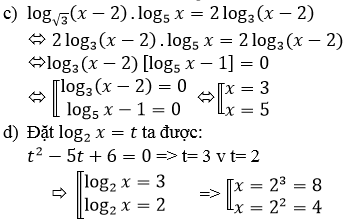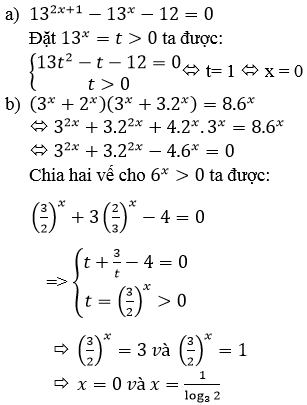Hãy nhập câu hỏi của bạn vào đây, nếu là tài khoản VIP, bạn sẽ được ưu tiên trả lời.

a) Đặt t = 13x > 0 ta được phương trình:
13t2 – t – 12 = 0 ⇔ (t – 1)(13t + 12) = 0
⇔ t = 1 ⇔ 13x = 1 ⇔ x = 0
b)
Chia cả hai vế phương trình cho 9x ta được phương trình tương đương
(1+(23)x)(1+3.(23)x)=8.(23)x(1+(23)x)(1+3.(23)x)=8.(23)x
Đặt t=(23)xt=(23)x (t > 0) , ta được phương trình:
(1 + t)(1 + 3t) = 8t ⇔ 3t2 – 4t + 1 = 0 ⇔ t∈{13,1}t∈{13,1}
Với t=13t=13 ta được nghiệm x=log2313x=log2313
Với t = 1 ta được nghiệm x = 0
c) Điều kiện: x > 2
Vì nên phương trình đã cho tương đương với:
[log3(x−2)=0log5x=1⇔[x=3x=5[log3(x−2)=0log5x=1⇔[x=3x=5
d) Điều kiện: x > 0
log22x – 5log2x + 6 = 0
⇔(log2x – 2)(log2x – 3) = 0
⇔ x ∈ {4, 8}

Điều kiện x>0.
Phương trình đã cho tương đương :
\(\log_3\left(x^2+2x\right)-\log_3\left(3x+2\right)=0\)
\(\Leftrightarrow\log_3\left(x^2+2x\right)=\log_3\left(3x+2\right)\)
\(\Leftrightarrow x^2+2x=3x+2\)
\(\Leftrightarrow x^2-x-2=0\)
\(\Leftrightarrow\begin{cases}x=-1\\x=2\end{cases}\)
Đối chiếu điều kiện ta có phương trình đã cho có nghiệm là \(x=2\)

Điều kiện : \(x>\frac{3}{4}\)
\(\Leftrightarrow\log_3\left(4x-3\right)^2-\log_3\left(2x+3\right)=2\)
\(\Leftrightarrow\log_3\frac{\left(4x-3\right)^2}{2x+3}=2\)
\(\Leftrightarrow8x^2-21x-9=0\)
\(\Leftrightarrow x=3\) hoặc \(x=\frac{-3}{8}\)
Đối chiếu điều kiện ta được nghiệm \(x=3\)

Câu a đúng là cú lừa, biến đổi logarit thì dễ, đến lúc nó ra pt vô tỉ theo x mới thấy vấn đề :D
a/ĐK: \(0< x< 1\)
\(2log_2x-log_2\left(1-\sqrt{x}\right)=log_2\left(x-2\sqrt{x}+2\right)\)
\(\Leftrightarrow log_2x^2-log_2\left(1-\sqrt{x}\right)=log_2\left(x-2\sqrt{x}+2\right)\)
\(\Leftrightarrow log_2\left(\dfrac{x^2}{1-\sqrt{x}}\right)=log_2\left(x-2\sqrt{x}+2\right)\)
\(\Leftrightarrow\dfrac{x^2}{1-\sqrt{x}}=x-2\sqrt{x}+2=x+2\left(1-\sqrt{x}\right)\)
Đặt \(1-\sqrt{x}=t\) (\(0< t< 1\)) \(\Rightarrow\dfrac{x^2}{t}=x+2t\)
\(\Leftrightarrow x^2-t.x-2t^2=0\) \(\Rightarrow\Delta=t^2+8t^2=9t^2\)
\(\Rightarrow\left[{}\begin{matrix}x=\dfrac{t+3t}{2}=2t\\x=\dfrac{t-3t}{2}=-t< 0\left(l\right)\end{matrix}\right.\)
\(\Rightarrow x=2\left(1-\sqrt{x}\right)\Rightarrow x+2\sqrt{x}-2=0\) \(\Rightarrow x=4-2\sqrt{3}\)
b/ĐK \(x>0\)
\(log_3\left(x-1\right)^2-log_3x+\left(x-1\right)^2=x\)
\(\Leftrightarrow log_3\left(x-1\right)^2+\left(x-1\right)^2=log_3x+x\)
Xét hàm \(f\left(t\right)=log_3t+t\) \(\left(t>0\right)\Rightarrow f'\left(t\right)=\dfrac{1}{t.ln3}+1>0\Rightarrow f\left(t\right)\) đồng biến
\(\Rightarrow f\left(t_1\right)=f\left(t_2\right)\Leftrightarrow t_1=t_2\)
\(\Rightarrow log_3\left(x-1\right)^2+\left(x-1\right)^2=log_3x+x\Leftrightarrow\left(x-1\right)^2=x\)
\(\Leftrightarrow x^2-3x+1=0\Rightarrow\left[{}\begin{matrix}x=\dfrac{3+\sqrt{5}}{2}\\x=\dfrac{3-\sqrt{5}}{2}\end{matrix}\right.\)

Điều kiện \(x^2-1>0\Leftrightarrow\left|x\right|>1\)
Bất phương trình tương đương với :
\(\log_3\log_{\frac{1}{2}}\left(x^2-1\right)<\log_3\Leftrightarrow0<\log_{\frac{1}{2}}\left(x^2-1\right)<3\)
\(\Leftrightarrow\log_{\frac{1}{2}}1<\log_{\frac{1}{2}}\left(x^2-1\right)<\log_{\frac{1}{2}}\frac{1}{8}\Leftrightarrow1>x^2-1>\frac{1}{8}\)
\(\Leftrightarrow2>x^2>\frac{9}{8}\)
\(\Leftrightarrow\sqrt{2}>\left|x\right|>\frac{3}{2\sqrt{2}}\) (Thỏa mãn)
Vậy tập nghiệm của bất phương trình là \(D=\left(-\sqrt{2};\frac{-3}{2\sqrt{2}}\right)\cup\left(\frac{3}{2\sqrt{2}};\sqrt{2}\right)\)

a) Tập xác định của hàm số là :
\(D=\left(-\infty;-4\right)\cup\left(4;+\infty\right)\)
b) Tập xác định của hàm số là :
\(D=\left(1;+\infty\right)\)
c) Hàm số xác định khi và chỉ khi \(\begin{cases}x^2-3x+2\ge0\\\sqrt{x^2-3x+2}+4-x\ge1^{ }\end{cases}\) \(\Leftrightarrow\) \(x\le1\) V \(x\ge2\)
Tập xác định là \(D=\left(-\infty;1\right)\cup\left(2;+\infty\right)\)
d) Hàm số xác định khi và chỉ khi
\(\begin{cases}\left|x-3\right|-\left|8-x\right|\ge0\\x-1>0\\\log_{0,5}\left(x-1\right)\le0\\x^2-2x-8>0\end{cases}\) \(\Leftrightarrow\) \(\begin{cases}\left(x-3\right)^2\ge\left(8-x\right)^2\\x>1\\x-1\ge1\\x<-2,x>4\end{cases}\) \(\Leftrightarrow\)\(x\ge\frac{11}{2}\)
Vậy tập xác định là \(D=\left(\frac{11}{2};+\infty\right)\)

Điều kiện x>1
Từ (1) ta có \(\log_{\sqrt{3}}\frac{x+1}{x-1}>\log_34\) \(\Leftrightarrow\frac{x+1}{x-1}>2\) \(\Leftrightarrow\) 1<x<3
Đặt \(t=\log_2\left(x^2-2x+5\right)\)
Tìm điều kiện của t :
- Xét hàm số \(f\left(x\right)=\log_2\left(x^2-2x+5\right)\) với mọi x thuộc (1;3)
- Đạo hàm : \(f\left(x\right)=\frac{2x-2}{\ln2\left(x^2-2x+5\right)}>\) mọi \(x\in\left(1,3\right)\)
Hàm số đồng biến nên ta có \(f\left(1\right)\) <\(f\left(x\right)\) <\(f\left(3\right)\) \(\Leftrightarrow\)2<2<3
- Ta có \(x^2-2x+5=2'\)
\(\Leftrightarrow\) \(\left(x-1\right)^2=2'-4\)
Suy ra ứng với mõi giá trị \(t\in\left(2,3\right)\) ta luôn có 1 giá trị \(x\in\left(1,3\right)\)
Lúc đó (2) suy ra : \(t-\frac{m}{t}=5\Leftrightarrow t^2-5t=m\)
Xét hàm số : \(f\left(t\right)=t^2-5t\) với mọi \(t\in\left(2,3\right)\)
- Đạo hàm : \(f'\left(t\right)=2t-5=0\Leftrightarrow t=\frac{5}{2}\)
- Bảng biến thiên :
| x | 2 \(\frac{5}{2}\) 3 |
| y' | + 0 - |
| y | -6 -6 -\(\frac{25}{4}\) |
Để hệ có 2 cặp nghiệm phân biệt \(\Leftrightarrow-6>-m>-\frac{25}{4}\)\(\Leftrightarrow\)\(\frac{25}{4}\) <m<6





Điều kiện \(\begin{cases}x\ne1\\x>\frac{1}{2}\end{cases}\)
\(\log_3\left(x-1\right)^2+\log_{\sqrt{3}}\left(2x-1\right)=2\Leftrightarrow2\log_3\left|x-1\right|+2\log_3\left(2x-1\right)=2\)
\(\Leftrightarrow\log_3\left|x-1\right|\left(2x-1\right)=\log_33\)
\(\Leftrightarrow\left|x-1\right|\left(2x-1\right)=3\)
\(\frac{1}{2}\)<x<1 và \(2x^2-3x+4=0\)
hoặc x>1 và \(2x^2-3x-2=0\)
\(\Leftrightarrow x=2\) thỏa mãn điều kiện. Vậy x=2